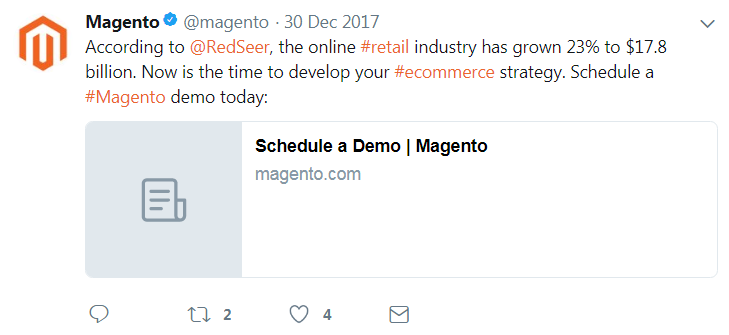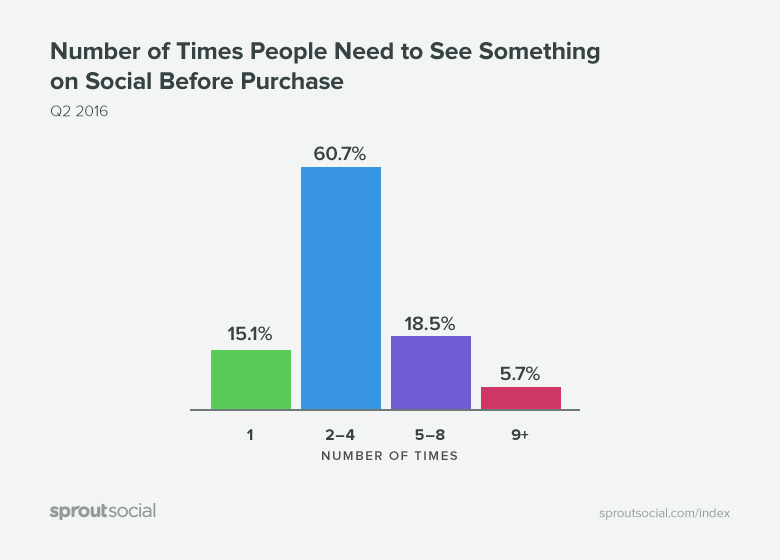A brand voice isn’t hard to create but it is a must.
The brand voice is more than snarky quips or positioning yourself by sounding authoritative. It’s a rallying call. A way for members of your community to back your claims and triumph your suggestions.
It provides personality when topics are dull.
The brand voice helps visitors know who they’re dealing.
It unifies the message.
Why a Brand Voice is Important
What makes your content different from the millions of other pages published each day?
No, seriously.
There’s not much of a difference between widgets sold from Company A vs Company B. They’re likely sourcing it from the same manufacturer. Except, they’re slapping on a different logo.
It’s the same with content and social media.

We follow brands for many reasons…
…but it’s the brand voice that keeps us engaged.
The voice turns an otherwise drab tutorial or story into something refreshing and edge-of-your-seat exciting. It adds humor or drama to the mundane. It’s the personality behind the historically cold aspect sales and marketing.
A brand voice makes the message relevant.
It lends authenticity to like-minded ideas, lingo, and phrases of the community. A way to appear part of the community – not an outsider.
The exceptional brands are ones that’ll get people interacting without pitching offers. People follow and flock to these personalities because they’re fun, controversial, or real.
These are brands with something to sell us…
…but it doesn’t feel like they’re selling.
The brand voice allows these human moments.
Defining the Tone of Voice

The tone of voice defines the people behind the brand.
Like we said…
Anyone can create content if they’re willing to put in some time. The whole concept of this post was spurred by a mix of research and personal experiences. You may not have noticed it but the way the post is structured, and choice of words add to the flavor.
You start to think… “ah, this is an AffiliatePrograms post”.
The Two Avenues of Tone of Voice
The brand’s tone of voice off-shoots in a lot of different directions.
But, it’s usually a choice between these two:
- Casual
- Formal
A casual tone of voice is like what you’re reading, now. It’s somewhat off-the-cuff but delivers its message without being too strict and rigid. It’s free-form. It’s the same as when you’re reading a favorite site or author when they’re telling a story or have a style to their content.
Think of it like journaling.

Then, you’ve got formal which is cold and sterile. It’s usually littered with industry jargon to check off a few boxes to make upper-management happy. It’s effective when doing business-to-business campaigns… but 99% of your efforts (we’re taking a guess here) will be trying to target an audience much like yourself… somewhat rough around the edges… again: human.

Which of these do you feel compelled to follow and interact?
Obviously, these are two contrasting examples — but it shows how you can be in a similar space (in their case: e-commerce platforms) and have a wildly different tone with your followers.
The Tone of Voice Ventures Out
Let’s say you decide the tone will remain casual – nice!
There’s no point to reinvent storytelling.
Take an angle and roll with it.

The tone can go any which direction whether you want to make people feel nostalgic about the “good ol’ days” or get worked up for a cause by pointing out the shortcomings of the establishment.
A lot of the tone will reflect your personality and experiences.
Should you put this front and center?
Well…
That depends if you’re a likable personality.
You can provide a positive message and get people talking. You could be a total butthole and still get people backing every word you say. The point is giving people that something real to get behind – giving them a voice through your voice.
How to Find Your Brand Voice

So, how do we go about finding a brand voice?
You could take a shotgun approach and try different writing styles and tones until something sticks based on the number of shares, likes, or site visitors.
Or…
You could use a (somewhat) scientific approach to defining your brand voice through a mix of research and development.
Either gets you to the goal.
Let’s dig into the step-by-step for the sake of simplicity:
Step 1: Where do you align?
Would you know the answer if someone asked your brand’s purpose that wasn’t about making money?
Finding your brand voice shares parallels with an elevator pitch.
It cuts the BS and explains what you offer.
But, more importantly: Why you’re offering it.
It reveals a value you get behind – an alignment for your efforts and business.
Maybe it’s something like:
- You want to disrupt an annoyingly antique industry
- You want to help others facing specific problems
- You want to bring joy to others while having fun, too
- You want to make something you can be proud of
This value creates a difference between you and the others.
Think about it.
Would you support a dime a dozen company selling the same, old widget sourced from China? Or, do you get behind the company (even if it’s sourced the same) wanting to use part of their proceeds and public awareness to support something you care for?
Find your values, and then…
Step 2: Meet halfway with the values and beliefs
We use the items we own as an expression.
A statement.
It’s why people gladly pay Apple hundreds more for a phone with comparable tech-specs as an Android equivalent. Or, why we’ve got sneakerheads going wild for vintage Yeezy’s when that money could easily cover rent. Hell, we’ll drop thousands for designer dogs so we’re different.
Deep down, there’s a set of values and beliefs shared between you and your audience.
How do you align this? Simple… ask and listen.
- Use your social media interactions as a basis for finding values and beliefs
- Send a questionnaire or short survey asking their problems and goals
- Look at how the competition positions itself and lurk their community
Look for what gets people fired up.
Can you target those with specific, shared values and beliefs? Great! Can you at least meet halfway to get them interested in what you have to say? Awesome!
This’ll let you stay focused on the audience willing to act. It’ll reinforce your efforts and align your brand voice to what they want to hear… not in a pandering way but a rallying-type way.
Step 3: Create a persona
You may choose not to use one if you’re writing from a personal angle.
But:
A persona can greatly help you (and the team) align the brand voice because it forces dialog through this personality. It creates a character with a set of reflected values and ideals.
It’s roleplay.
Some find it easier to craft their content and marketing messages this way.
They become the narrator.
Describe this person:
- Are they adventurous or frightful?
- Are they driven or laid back?
- Are they commanding or shy?
- Are they an expert or fan?
Take one of your best followers if it helps – define the persona as this person (much like a customer avatar) but with your message behind the dialog.
Make sense?
Step 4: Put it into action
Sit down. Relax. Write.
Write like you’re talking to your best friend while having strong drinks. Share a story you find hilarious or sell them an awesome, new idea. Don’t hold back. Write how you talk.
Fire up that passion about your favorite topic.
Be bold.
Okay, okay… we’re getting too lifestyle design-y here.
The best way to find your brand voice and see it in action is by doing. The more content you create – the more social you are – the more people you interact with – will help develop your voice. It’s the same as meeting a new group of people in that you start off shy but become loud once you feel at ease.
Step 5: Commit
You’ll find your voice in due time.
It’ll affirm based on the positive response from your community.
Take what works and make it part of the routine.
- Defined your brand as humorous? Stick to funny pieces
- Always drama and happenings? Remain serious
- Light-hearted and whimsical? Keep enjoying yourself
It’s quick work alienating a community when you do a 180 with your brand voice. They suddenly feel like they’ve lost their connection. Almost a twinge of abandonment. You can take small pivots into new directions, but you’ll generally want to stick to the same voice from here on out.
Think of it like your favorite band suddenly putting out a concept album.
You think “This isn’t like their old stuff? Ehhhhh”.
That connection isn’t there anymore and you’re likely to move on.
Same for how people follow your business.
So… commit.
Creating Brand Voice Guidelines
Brand voice guidelines come in handy when there are multiple parts to the whole. Meaning, you’re using multiple people or teams to handle different aspects of the business. This unifies the message and clarity of the voice across these channels without causing confusion, conflict, or embarrassment.
SproutSocial found it takes 2-4 times before someone will make a purchase on social media.

Imagine the difficulty of this response if each message was inconsistent!
The purpose of creating brand voice guidelines is to lower the onboarding time it takes when bringing in new talent. It acts a general set of rules of what content creators can and cannot do this way content schedules are streamlined, and the message stays uniform.
Create a simple brand voice guideline by including the following:
- Examples of exemplary content
- Quotes and social shares
- List do’s and don’ts of brand mentions
- Common words and phrases
- Grammar guidelines
But really… it’s any example you feel best displays your brand voice.
Spend the Next 5-Minutes Doing This
The easiest example would be pulling your top-performing content and highlighting sections which accurately display your brand voice and tone. It can include notes and references to clarify concepts.
Otherwise, if you’ve yet to develop a solid brand voice, you could borrow guidelines from reputable companies within your space as a starting point. Then, adapt their guidelines to your own.
You could include these snippets in:
- A shared, Google document
- An internal webpage
- A media swipe file
You’ll want to keep this file on hand since the tone of voice and brand direction is bound to evolve. The evolution happens as you find your core team and audience. Sometimes it’s the result of a wildly successful marketing campaign or viral post.
Either way, come back to this document on a quarterly or yearly basis to realign goals. Update the document to help new (and old) creators build upon past, successful efforts.
Then, Keep It Consistent
Place the task of following brand voice guidelines on a senior person in the business. One who has been a part of the operations since the beginning – or at least the early days. This is the person that has seen and helped influence the brand voice throughout the years; they know what works.
If you need – create a chain of operations:
- Writer
- Editor
- Lead editor
Else, if you’re a small operation:
- Refer to the guideline
- Re-read the content before publication
- Make edits post-publication where necessary
Consistency is key to building a memorable brand voice.
Conclusion
The direction you choose when developing a brand voice is a task taken on by you, alone. You have a vision for the business – now, align the message by creating guidelines. Find out what you want people to hear and mold your message using the steps provided in this post.
Play with it.
It takes some business many years before they hit their stride. Best to try a variety of tones and styles when everything is young and fresh versus cornering yourself once it’s established. It’s a fun process watching it evolve and receiving feedback.
Let us know if this has helped with aligning goals.




